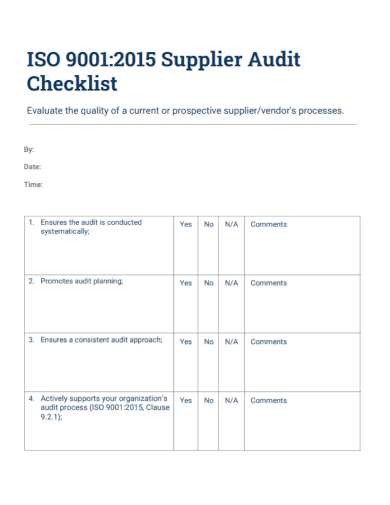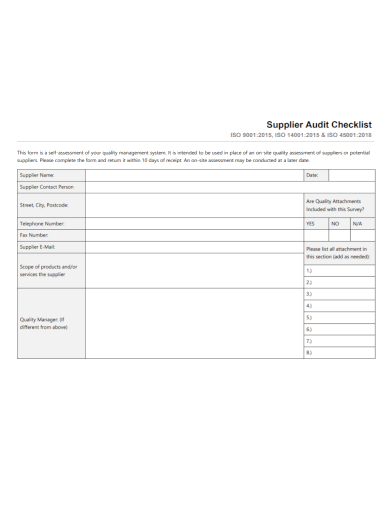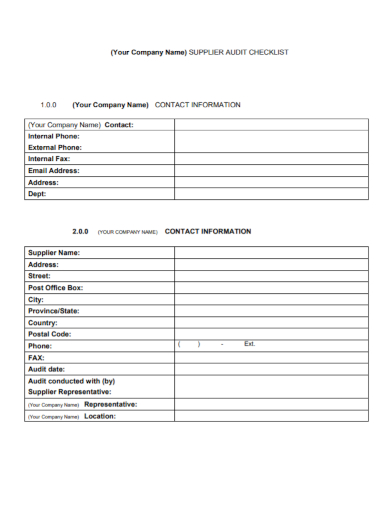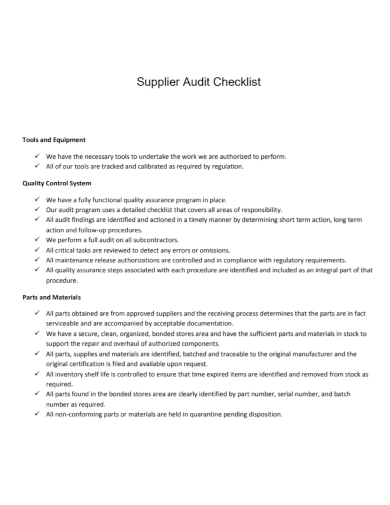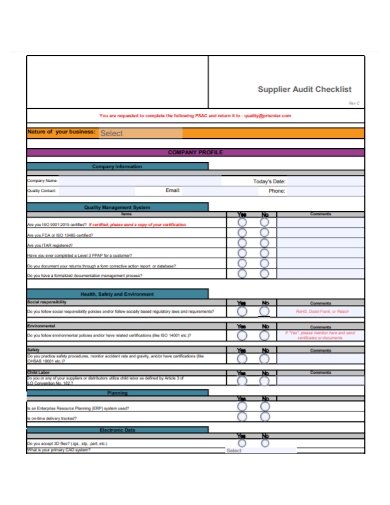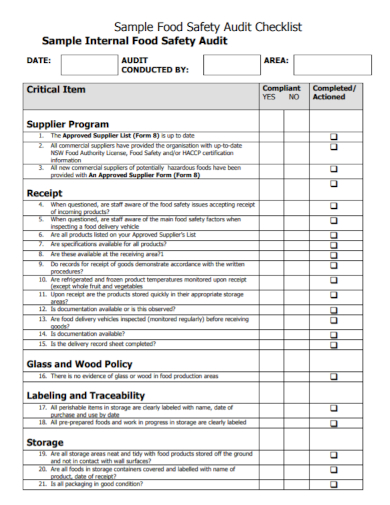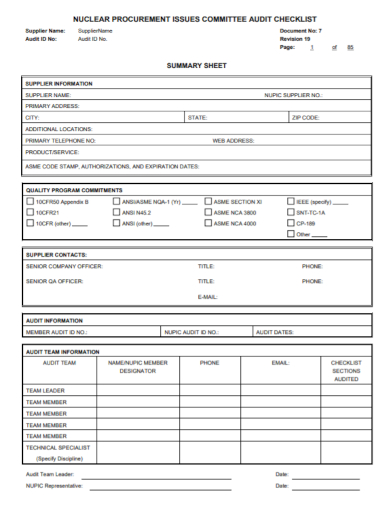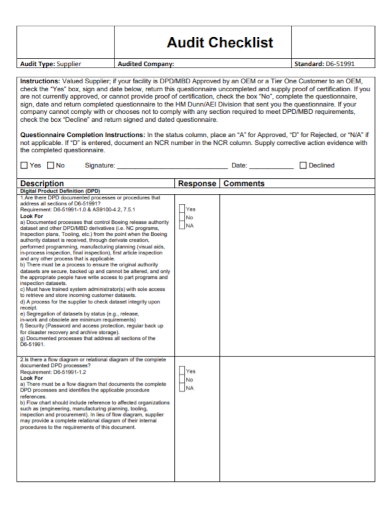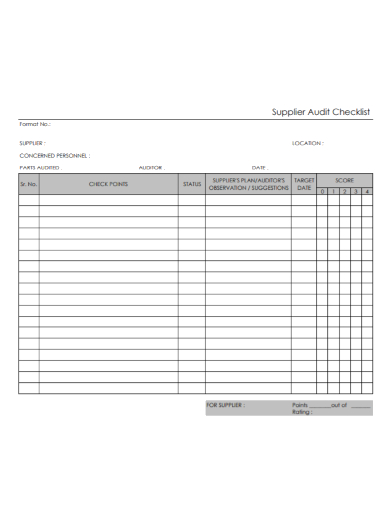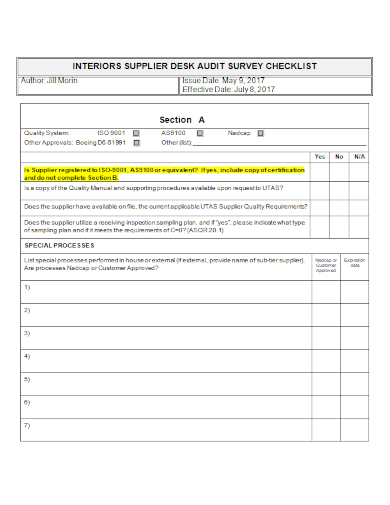Having discovered a new supplier for your business can feel really good. Especially when your prospect can provide a wide variety of products that you have long since needed. Provided with a professional presentation and a great medium for mass communication, it’s easy to get hopeful that you may have finally found the perfect business partner. However, as a businessman, experienced or not, you should know better that to immediately rush a massive order of raw materials from this new supplier. Equipped only with high hopes for your assurance. Proper diligence requires supplier evaluations that evaluate their products and services with the use of an effective supplier audit checklist to make sure that the goods that you are receiving is what was advertised.
Supplier audit checklists help you avoid potential production problems and disasters. Suppliers don’t usually have large laboratories or facilities to inspect the material composition of the products themselves. Nor are there any mention of such facilities in the company records. You know these details because these are some of the requirements needed for a business partnership and past subsequent reports. It’s just also better that you yourself are confident enough of your products and with your supplier, rather than just leaning on to your assurances. Regardless of how confident you may be with your newfound supplier, there’s just no substitute to having a well written supplier audit checklist on hand and ready to use. It just allows you to verify your supplier’s capabilities and avoid potential production issues in the near future. But before you can actually write your own supplier audit checklist, be sure that you have a sense of familiarity with the document. Check out these supplier audit checklist samples that we have listed for you down below. Once you’ve gotten yourself acquainted with the document, feel free to use these samples as guide or even as templates to draft your own piece of document.
10+ Supplier Audit Checklist Samples
1. Supplier Audit Checklist
2. Sample Supplier Audit Checklist
3. Company Supplier Audit Checklist
4. Standard Supplier Audit Checklist
5. Printable Supplier Audit Checklist
6. Supplier Food Safety Audit Checklist
7. Supplier Committee Audit Checklist
8. Audit Checklist for Supplier
9. Vendor Supplier Audit Checklist
10. Basic Supplier Audit Checklist
11. Supplier Desk Audit Survey Checklist
What Is a Supplier Audit Checklist?
A supplier audit checklist is a largely important tool to use in comparing business practices or production processes of a certain supplier or manufacturer. Comparing these components to a set of requirements or standards established by you, the client, or the ISO standards. A supplier audit checklist contains everything that is needed to complete an audit process or an inspection in an accurate and efficient manner. It’s a systematic examination of the production process of the supplier and asses conformance with a pre-established set of standards. The audit is usually conducted by an appointed auditor or inspector. Passing a supplier audit gives you that extra layer of assurance that whatever you may be receiving from your new supplier, is up to par with the standards you have identified. The document is a very important tool especially for importers that require a series of quality checks for multiple components of the production process. It improves the overall quality of the products and services that you are offering and just results in better quality overall.
What Should Be Included in a Supplier Audit Checklist
The company or the client may have their own set criteria for quality checks and verification during an audit. Regardless, supplier audit checklists should be able to cover most if not all of these components listed below.
- Zero tolerance for severe violations
Companies typically allow for small mistakes and mishaps from the expectations in the checkpoints of the checklist. However, you should remember that it is generally wise not to be too complacent and lenient with these violations. Especially in the more serious ones. - Basic facilities, environment, and maintenance
It would also be best to tour the facility of your potential business partner beforehand since it is a significantly basic and vital part of the overall audit process. Appointed auditors should record their findings in a separate relevant section of the checklist to fully cover the production and manufacturing facilities. - Quality management system organization
An audit checklist has to include a section that is dedicated to the supplier’s quality management system. This section is vital in order to understand the quality standards of your supplier and if they meet them. - Incoming quality controls for materials and components
The supplier shouldn’t cut costs by using inferior substandard materials. Quality measures of raw materials help make sure that this does not happen to you or your company. The use of substandard materials make production very difficult and highly costly to remake than just using the appropriate recommended ones. - Identify quality issues through during production protocols
During production protocols are inspections that are done during the actual production and manufacturing process of your order. It helps you and your supplier immediately identify issues as they arise and address them even before they could cause any other significant problem. - Finished goods control and inspection
Although during production controls are necessary and is usually highly effective, some issues still manage to come through and some even surface only during the packaging process. That is why it is still useful to have a final control and inspection after the product has been through the complete production process and is already on its way to packaging. - Lab testing capabilities
Laboratory testing is a very important part of an inspection especially for manufacturers who deal with components that frequently needs to be lab tested. Evaluating lab testing capabilities can be a potential deal breakers for importers whose components need to be lab tested. - HR Recruitment and training
A declining workforce is the last thing you need in looking for a supplier that can meet your requirements. Lack of manpower and shift changes can lead to production delays and further issues in quality. That is why audit checklists should have a separate section dedicated to the structure of the company’s training programs for new and current employees, new employee orientation, and formal training records. - Engineering, research, and design capabilities
Although it is not completely mandatory, a lot of importers and suppliers appreciate the presence of having proper engineering capabilities and design teams to be able to handle on site productions. These components greatly contribute if you want a partner that can develop new products unique to the ones they’re already working with. - Business development and management behavior
It is important that your supplier has a positive organizational structure and management attitude. These things tell you about how much ability your supplier currently has to effectively communicate with their clients and their customers.
FAQs
What are the three types of quality audits?
Process audit, product audit, and system audit.
How do you audit a supplier?
- Conduct pre-audit research
- Review the supplier’s reputation
- Don’t take customer complaints for granted
- Know if a supplier is outsourcing
- Keep the audit on track
Why do we audit suppliers?
A supplier audit audit provides a complete and comprehensive inspection at supply chain performances to identify corporate winners and losers. Suppliers can have a significant effect on the overall quality of your products and many of the factors that contribute to poor quality comes from supplier related issues.
Other more specific components like requirements and product criteria vary from one supplier to another. These details are based upon whatever product or service they may be offering to their clients. So when looking for a potential business partner, these things and more might be something that you want to take a look at. Working with third party suppliers come with their own set of risks, but having a trusty supplier audit checklist on hand lets you evaluate these risks to gauge if the venture is really worth it or not.
Related Posts
FREE 19+ Onboarding Checklist Samples
FREE 19+ Sample Inventory Checklist
FREE 13+ Compliance Checklist Samples
FREE 10+ Deployment Checklist Samples
FREE 10+ Operating Procedures Samples
FREE 10+ Contractor Management Procedure Samples
FREE 10+ Accounts Payable Samples
FREE 7+ Sales Sheet Samples
FREE 7+ Distributor Assessment Form Samples
FREE 19+ Sample Request For Proposal
FREE 17+ Sample Visit Reports
FREE 13+ Distribution Management Samples
FREE 10+ Chemical Inventory Samples
FREE 10+ Trade Show Checklist Samples
FREE 10+ Company Profile Samples

